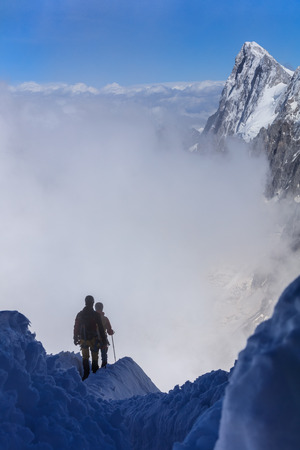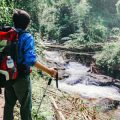1. Leave No Trace, Pack It In, Pack It Out
The Bedrock of American Hiking Ethics
In the U.S., hitting the trail isn’t just about adventure—it’s about responsibility. The foundational principle every hiker is expected to follow is “Leave No Trace.” This isn’t just a slogan; it’s a code deeply woven into the fabric of American outdoor culture. Whether you’re trekking through a national park or exploring local trails, minimizing your impact on nature is non-negotiable.
Pack It In, Pack It Out: The Unwritten Rule
If you brought it with you, you take it out—no exceptions. That means every energy bar wrapper, water bottle, tissue, and even biodegradable items like orange peels or pistachio shells. To many newcomers, tossing an apple core into the brush might seem harmless, but experienced hikers know that even organic waste disrupts local wildlife and can take months to decompose. Nothing gets left behind—not even crumbs.
Staying on Trail: Protecting More Than Just Your Shoes
It’s tempting to blaze your own path or take shortcuts, especially when the main trail is muddy or crowded. But in American hiking culture, stepping off marked paths is a cardinal sin. Going rogue not only damages fragile vegetation and causes erosion but can also lead others astray, compounding environmental harm. Trails exist for a reason—respect them.
Why It Matters: Stewardship Over Scenery
At its core, Leave No Trace is about stewardship—a recognition that these wild spaces belong to everyone and no one at the same time. The goal isn’t just to enjoy the scenery but to ensure future generations can experience unspoiled wilderness too. In the U.S., being a true hiker means living by this ethic every step of the way.
2. Greetings: The Trailhead Handshake
In the United States, hiking isn’t just about conquering miles and summits—it’s a social experience governed by subtle codes of conduct. One of the most fundamental is the custom of greeting fellow hikers, often referred to as the “Trailhead Handshake.” This ritual isn’t always a literal handshake, but rather a set of time-honored gestures and verbal cues that signal respect, camaraderie, and situational awareness among those who share the trail.
Unspoken Rules of Trail Greetings
Whether you’re trekking through the Rockies or ambling along Appalachian paths, encounters with other hikers are inevitable. Americans typically exchange casual nods, a friendly “Hey there!” or “Good morning!”, and sometimes brief eye contact—a blend of politeness and practical communication. These greetings aren’t just pleasantries; they serve vital functions:
- Camaraderie: A simple greeting affirms shared purpose, acknowledging that everyone is in this together.
- Safety: Eye contact and short exchanges allow hikers to size up intentions and state—are they lost, tired, or in need of help?
- Awareness: Verbal exchanges can subtly check for awareness of trail conditions or wildlife sightings.
Common Trail Greeting Styles
| Gesture/Expression | Description | When to Use |
|---|---|---|
| Nod/Smile | A quick head nod or genuine smile; silent acknowledgment. | Passing on narrow trails or when conversation isn’t practical. |
| “Hey there!” / “Howdy!” / “Morning!” | Short, friendly phrases common across U.S. regions. | Early in the day or when energy is high; universal opener. |
| Eye Contact | A brief meeting of eyes signals alertness and non-threat. | Always—especially important when alone or in remote areas. |
| Hand Wave | A quick wave replaces words when distance or wind makes talking tough. | On open ridges or wide trails where sound doesn’t carry well. |
The Safety Layer: More Than Manners
This greeting ritual isn’t just about being polite. On U.S. trails, acknowledging others helps create a network of mutual lookout. If someone fails to return a greeting, it might be a red flag—are they injured, lost, or simply unfriendly? Experienced hikers use these micro-interactions as data points for situational awareness. In essence, the trail greeting acts as both icebreaker and silent safety check-in—a tradition that’s as much about survival as it is about sociability.

3. Right of Way: Who Steps Aside
On the American trail, knowing who yields is a critical piece of backcountry etiquette—and it’s more than just polite, it keeps everyone safe and the flow smooth. The rules aren’t always posted, but seasoned hikers live by them. Here’s how to handle right-of-way situations when you’re trekking U.S. trails crowded with a mix of people, bikes, horses, and even wildlife.
Uphill vs. Downhill Hikers
The cardinal rule on most U.S. hiking trails: uphill travelers have the right of way. Climbing takes more effort, and stopping mid-ascent can kill your momentum (and spirit). If you’re descending, step aside, find stable ground, and let those grinding up pass first. If they wave you through, thank them and move quickly—but don’t expect it as a given.
Groups vs. Solo Travelers
When groups meet solo hikers, the group usually yields—especially if the group is large and can easily shuffle to the side. This prevents bottlenecks and lets solo or smaller parties keep their rhythm. Groups should hike single file when others approach and communicate clearly about who’s passing where to avoid confusion or accidental elbows.
Multi-Use Trails: Horses, Cyclists, and Foot Traffic
Horses
On any trail where horses are allowed, they always get top priority. Step off the trail on the downhill side (horses are less likely to be spooked this way), speak calmly to both rider and animal so you don’t surprise them, and wait until they’ve fully passed before stepping back on.
Cyclists
Bikes generally yield to hikers unless local signage says otherwise. Mountain bikers are fast and nimble but should slow down or stop for foot traffic. If you hear a bike coming, stay alert—move aside only if there’s room and safety allows. Cyclists should announce themselves well in advance (“On your left!”) so nobody gets startled.
Wildlife Encounters
If you come across wildlife—whether it’s deer, elk, or something toothier—humans always yield. Give animals plenty of space, never try to pass closely or harass them for a better photo op. Sometimes that means backing up or waiting it out; your destination isn’t worth a wildlife encounter gone wrong.
Pro Tip: When in Doubt, Communicate
The unspoken code works best with clear communication. Eye contact, a friendly nod, or a simple “go ahead” can save everyone confusion—or worse. Remember: on America’s trails, respect for others’ space and pace is what keeps the wilderness welcoming for all.
4. Trail Silence and Personal Space
When you lace up your boots and hit the trail in the U.S., youre stepping into a culture that highly values both the serenity of nature and the personal space of fellow hikers. One of the most critical—yet unwritten—codes is maintaining respectful noise levels, which preserves the wild atmosphere for everyone. Whether you’re trekking solo or with a group, understanding when to keep quiet and how to interact can make or break the outdoor experience.
Noise Levels: The Unspoken Agreement
Nature’s soundtrack—the wind through pines, birdsong, distant water—is sacred to many hikers. Loud conversations, shouting across switchbacks, or cranking up music not only disrupts this peace but can also disturb wildlife and other hikers seeking solitude. Here’s a quick breakdown:
| Situation | Recommended Noise Level | Common Practice |
|---|---|---|
| Passing Other Hikers | Low (greetings only) | Soft “hello” or nod |
| Rest Stops/Scenic Overlooks | Low to Moderate | Quiet conversation, minimal laughter |
| Main Trail Walking | Very Low | No speakers, hushed voices |
| Campsites at Night | Minimal/Whispered | Respect posted “quiet hours” |
Music Speakers and Technology Etiquette
The use of portable speakers is a controversial topic on American trails. While some may wish to enhance their hike with music or podcasts, most seasoned hikers agree: headphones are acceptable, but broadcasting sound is not. If you want tunes, keep them private. This rule helps maintain the immersive natural environment that draws people outdoors in the first place.
Speaker Use: Hard No in Most Cases
- Headphones Only: Always use headphones if you need audio entertainment.
- No Speaker Zones: Assume every trail is a no-speaker zone unless specifically allowed (which is rare).
- Wildlife Considerations: Loud noises can scare away animals and disrupt their habitats.
Personal Space: The Invisible Bubble
American hiking culture deeply respects personal boundaries. When passing others on narrow paths, it’s common courtesy to step aside briefly or wait at wider spots. Crowding at viewpoints or speaking loudly near others’ rest spots is frowned upon.
Trail Conversation Volume Guidelines:
- If you’re close enough for someone to hear your normal speaking voice, lower it by a notch.
- If sharing stories or jokes in a group, save the belly laughs for after the hike.
- If in doubt, follow the lead of quieter hikers around you.
Navigating these unspoken rules ensures everyone gets what they came for—a safe journey, respect from others, and above all, a chance to reconnect with the wild without unnecessary distractions.
5. Helping Hands and Emergency Codes
On American trails, the code of mutual support runs deep—sometimes unspoken, but always understood. Lending a hand isn’t just encouraged; it’s a core part of the hiking ethos. Whether you’re trekking the Pacific Crest Trail or navigating an Appalachian backwoods loop, hikers are expected to look out for each other. Here’s how these unwritten rules play out in real-world scenarios.
When Offering Help Is Expected
If you see someone limping, struggling with their pack, or clearly lost, it’s standard practice to check in: “You good?” or “Need a hand?” In the U.S., ignoring a fellow hiker in obvious distress is considered bad trail karma. But don’t overstep—offer help without being intrusive, and respect the other person’s autonomy.
Common Distress Signals
The universal sign for emergency is three: three shouts, three whistles, or three flashes of light—repeated at regular intervals. This signals that someone needs immediate help. On most popular American trails, carrying a whistle is smart; it cuts through wind and distance when your voice won’t. If you hear this pattern, drop what you’re doing and investigate.
Etiquette for Asking or Declining Assistance
If you need help, be clear and direct: “I’m having trouble with my ankle—could you spare some tape?” Conversely, if someone offers assistance and you’re okay, don’t just brush them off. A simple “Thanks, I appreciate it—I’ve got this” keeps the interaction friendly and respectful. If you feel uncomfortable accepting help from a stranger but need support, set boundaries: “Could you wait while I try to fix this myself? I’ll shout if I get stuck.” The key is honest communication—it keeps everyone safe without compromising personal comfort zones.
6. Social Media and Sharing Spots
In the age of Instagram and TikTok, sharing your epic summit selfie or that hidden waterfall has become second nature for many hikers. But with great reach comes great responsibility. The debate over “geotagging” — posting the exact location of a trail or natural feature online — has split the U.S. hiking community down the middle.
The Double-Edged Sword of Geotagging
On one hand, geotagging can help others discover new adventures and support conservation through increased public interest. On the other, it can turn once-pristine spots into overcrowded hotspots overnight, accelerating erosion, littering, and habitat destruction. If you tag a fragile area, you might unintentionally contribute to its downfall.
When (and When Not) to Share
The unwritten code is simple but serious: Think before you post. If a location is already well-known, like Yosemite’s Half Dome or the Appalachian Trail, geotagging usually isn’t an issue. But if you’ve stumbled across a little-known alpine lake or a delicate wildflower meadow, consider leaving out the GPS coordinates or using broad tags like “Pacific Northwest” instead of specifics. This keeps fragile environments off the viral map.
Protecting What You Love
Ultimately, respect for nature means protecting it even from our own excitement to share. Many seasoned hikers now advocate for “Leave No Trace online” as much as on the ground. Highlight stewardship in your captions — remind followers to pack out trash, stay on trail, and tread lightly. Sharing responsibly ensures these wild places remain wild for generations of hikers yet to come.
7. Gear Talk and Trail Beta
Out on the American trails, there’s a unique and almost ritualistic tradition that hikers quickly come to recognize: gear talk. This isn’t just casual small talk—it’s practically a rite of passage, and an unspoken handshake between those who live for the backcountry. Whether you’re passing someone on the Appalachian Trail or sharing a rest spot in the Rockies, expect a conversation about boots, packs, water filters, or tents. Americans love their gear, and they don’t hesitate to share opinions—sometimes bluntly—on what works and what fails in the wild. It’s more than showing off; it’s about survival, efficiency, and comfort out where mistakes can mean blisters or worse.
The Beta Exchange
Another cornerstone of trail culture is the swapping of ‘beta’—real-time intel about trail conditions, weather updates, water sources, wildlife sightings, or hazards ahead. This info is gold and is freely exchanged with both friends and complete strangers. If you’ve got fresh information, you’re expected to pass it along. If you need beta, don’t be shy; ask directly and listen up. It’s not only helpful but also considered good trail citizenship.
No Gatekeeping
Gatekeeping—hoarding info or giving misleading advice—is frowned upon. The ethos here is mutual support; everyone benefits when knowledge flows openly. That said, respect comes from sharing honest experiences without exaggeration or ego.
Real-World Examples
You might hear a hiker say, “There’s a solid water source two miles north—last one until the ridge,” or get unsolicited but well-meant advice on how to patch your pack with duct tape. Don’t take offense; this communal problem-solving is part of what makes American hiking culture resilient and adaptive.
In short: gear talk isn’t bragging; it’s survival strategy. Sharing beta isn’t optional; it’s an expectation. Master these codes, and you’ll find yourself welcomed—and respected—by trail veterans from coast to coast.


